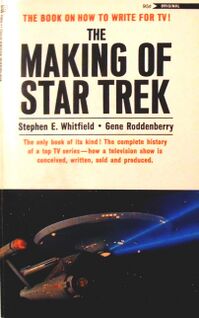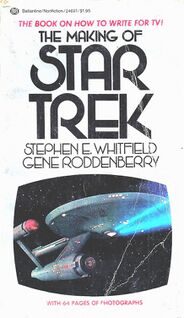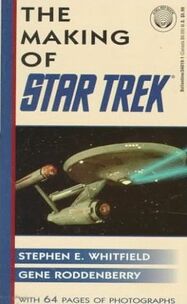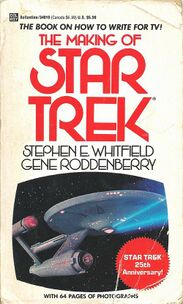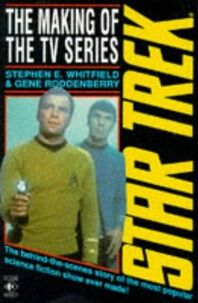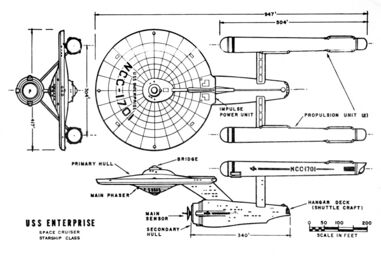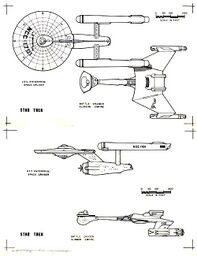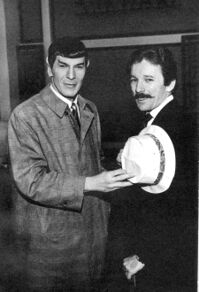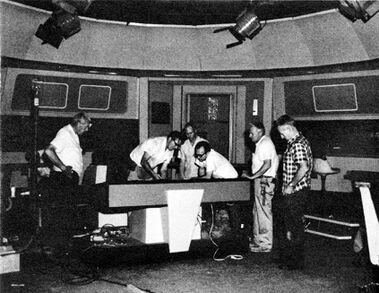The Making of Star Trek
| Real-World |
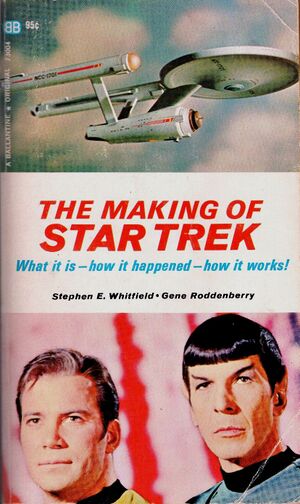 First edition cover (used for the first four printings) | |
| Author | Stephen E. Whitfield and Gene Roddenberry |
|---|---|
| Published | September 1968 January 1977 (Del Rey) 14 November 1991 (Titan Books) |
| Publisher | Ballantine Books Del Rey Books Titan Books |
| Pages | 414 (counted, 480 including uncounted photo sections) |
| ISBN | 0345216210 |
The Making of Star Trek is a behind-the-scenes description of the creation of Star Trek: The Original Series, the first Star Trek series. A multi point of view reference book, in which input from a wide range of production contributors, from studio executives to costumers, was processed, it was the first of its kind. Liberally illustrated with two extensive black and white photo sections, this book also contains as illustrative backdrops, memos, technical information, and production concepts from the original pilot through the first two seasons of The Original Series.
Published in 1968, while the Original Series was still in production, the book holds the distinction of being the very first officially licensed reference book of its kind on the subject of Star Trek, as well as adding a third element to the infant Star Trek print franchise after the first official novel and comic publications the previous year.
Summary[edit | edit source]
- From the first edition book jacket
- What it is – how it happened – how it works! The Biography of the Leading Science Fiction TV Program. STAR TREK! The long, hard battle of television's first tentative step toward adult science fiction, with the complete story on how the U.S.S. Enterprise was designed, her weaponry, equipment and power sources, the original concept behind the show, how the continuity is maintained, backgrounds of the characters, biographies of the stars, and pictures, diagrams, illustrations – the whole authentic history.
- From the second edition book jacket
- The Book On How to Write for TV! he only book of its kind! The complete history of a top TV series – how a television show is conceived, written, sold and produced.
This article contains excerpts of copyrighted sources which are included for review purposes only, without any intention of infringement. |
Contents[edit | edit source]
- As listed in the first edition
- Introduction, p.11
- Part I: Birth Pangs
- Photo inset, 32 pages, unnumbered
- Part II: An Official Biography of the Ship and its Crew
- Chapter 1. Prelude, p. 163
- Chapter 2. The USS Enterprise (NCC-1701), p. 171
- Chapter 3. Mission and Men, p. 202
- Chapter 4. The Ship's Captain, p. 214
- Chapter 5. Mr. Spock, p. 223
- Chapter 6. Chief Medical Officer, p. 239
- Chapter 7. Engineering Officer Scott, p. 244
- Chapter 8. Other Star Trek Regulars, p. 247
- Chapter 9. The Bad Guys, p. 256
- Photo inset, 32 pages, unnumbered
- Part III: From Then Until Now
- Chapter 1. Putting the Show on the Road, p. 261
- Chapter 2. These Are the Voyages, p. 286
- Chapter 3. Steady As She Goes, p. 301
- Part IV: The Star Trek Production – A Closer Look
- Chapter 1. In the Beginning Was the Word, p. 323
- Chapter 2. Making the Scene, p. 333
- Chapter 3. Feinbergers, Tribbles and Other Things, p. 342
- Chapter 4. Hunting for Aliens, p. 347
- Chapter 5. Metamorphosis: Humans and Humanoids, p. 351
- Chapter 6. Aliens – Dressed and Undressed, p. 355
- Chapter 7. Quiet in the Set, Please!, p. 362
- Chapter 8. Beyond Human Ken, p. 369
- Part V: Whither Star Trek?
- Chapter 1. Seasons Follows, p. 379
- Chapter 2. Bits an Pieces, p. 393
- Chapter 3. Whither Star Trek?, p. 400
- About the Authors, p. 403
- Star Trek Shows, p. 404 (Episode listing for seasons 1-2)
Background information[edit | edit source]
- For his research, author Stephen Edward Poe was given full access to the stages and offices of Desilu Productions, as part of the deal he brokered between model kit manufacturer Aluminum Model Toys (AMT) and the studio. Poe, who wrote the book using his stepfather's name of "Whitfield" (although virtually all his other writing was done under his own name), shared a co-author credit with Star Trek creator Gene Roddenberry. However, Poe wrote the book alone, but made a deal with Roddenberry, in which they agreed that Roddenberry would proofread the book and make his corrections and notifications before it went to print. For this, he would receive co-author credit and half the royalties. It also was thought that the appearance of Roddenberry's name on the book might make it sell better. Ultimately, Roddenberry was not able to review the book due to harsh production deadlines, but received the co-author credit, as well as half of the royalties, anyway. (Inside Star Trek: The Real Story, p. 402)
- The illustrations and photographs in the book were provided by the Paramount Publicity Department as well as by The Westheimer Company. (p. 15)
- Bonnie Trust transcribed Poe's copy, notes and interviews, and her work was described by an appreciative Poe as "herculean." (p. 15)
- Though his builds were prominently featured in the book, Wah Chang was the one major production staffer Poe could not mention by name in his book, as the former had no formal Prop Makers Union permission to work on the show.
- Poe began gathering his information shortly before or after the start of production on the second season and wrote his copy when that season went into hiatus. His writing was centered around the contents of the The Star Trek Guide, the later in-lore-famed "Writer's Bible", Roddenberry had disseminated on 17 April 1967 to his production staff during the pre-production stage of the second season. As a consequence, only cursory information on the series' third season is incorporated in the book, limited to what little preliminary pre-production information became available to Poe while he was finishing up on his copy.
- Exemplary of the last minute information was his inclusion of design sketches by Matt Jefferies for the Klingon D7-class battle cruiser, which was only introduced in the third season and had yet to premier onscreen when the book was published. Ironically, by not mentioning the AMT connection for this design, Poe (whose primary responsibility was to develop a Star Trek model kit line for his employer in conjunction with Jefferies) started a four-decades-long misconception that the D7 was a studio initiative, which it was not. As it turned out, Jefferies had designed the ship exclusively for AMT – who eagerly wanted to do a follow-up for their hugely successful 1966 Enterprise model kit – in his own spare time, and definitely not for the studio, which had not commissioned it, despite assertions and assumptions by numerous reference authors, fans, and the franchise itself to the contrary afterwards. Nevertheless, under their exclusivity agreement, the strapped-for-cash studio immediately appropriated one of AMT's two tooling masters for filming purposes. It was only in 2002 that Jefferies finally set the record straight. (Star Trek: The Magazine Volume 2, Issue 9, p. 66)
- This work has been an influential one. Not only was it the very first detailed and specialized book title on the production aspects of Star Trek, it was also the very first one for a television show in general, or for that matter one of the very first for the motion picture industry as a whole. Prior to its release, publications about "behind-the-scenes" aspects of motion picture productions were either restricted to article-length magazine publications, most notably in American Cinematographer, or referenced in (single point of view) memoirs or biographies of actors and/or directors. This book set the template for all "making of..." reference books on the subject matter that have followed suit.
- The book was highly successful, already needing a reprint in November of the same year it was first published, September 1968, followed by a third printing in January 1969, having by that time sold over a million copies, according to Susan Sackett. (Return to Tomorrow - The Filming of Star Trek: The Motion Picture, p. 417) A popular book, it has since then seen numerous reprint runs, first under the Ballantine Books imprint and subsequently under that of Del Rey, for two decades seeing at least one reprint each consecutive year. It has been, to date, the most reprinted Star Trek reference book ever. The 1991 stand-alone Titan Books publication was intended specifically for the UK market only, on the occasion of Star Trek's 25th anniversary. Despite its immense popularity, and unlike later reference books, it has not seen any internationally translated versions.
- In their book The Making of Star Trek: Deep Space Nine (p. x), Judith and Garfield Reeves-Stevens gave this publication high praise, commenting, "It is a true classic of its kind. Not just as a chronicle of the beginning of what was to become an unprecedented, billion-dollar entertainment franchise, and not just as a behind-the-scenes trove of trivia for die-hard Star Trek fans, but as a fascinating account of the creative reality of weekly television series production in the 1960s."
- Although it was followed in 1973 by The Trouble with Tribbles, which detailed the making of the episode of the same name, for many years this was the sole book title on the production of a Star Trek series as a whole, and thirty years later, Poe followed up on his work with the similarly conceived 1998 title A Vision of the Future - Star Trek: Voyager. The book also inspired the reference book The Making of Star Trek: Deep Space Nine.
- The Star Trek: Deep Space Nine production staff used The Making of Star Trek when working on “Trials and Tribble-ations”. (The Magic of Tribbles: The Making of Trials and Tribble-ations)
US print history[edit | edit source]
- Note: this list is currently incomplete
- Ballantine Books
- Original cover design
- No ISBN number
- 1st printing, September 1968 (cover price $0.95)
- 1st printing, October 1968 (Canadian)
- 2nd printing, December 1968 (cover price $0.95)
- 3rd printing, January 1969 (cover price $0.95)
- 4th printing, April 1969 (cover price $0.95)
- 1st printing, September 1968 (cover price $0.95)
- No ISBN number
- First revised cover design
- Attributed ISBN 0345216210
- 5th printing, July 1970 (cover price $0.95)
- 6th printing, November 1970 (cover price $0.95)
- 7th printing, June 1971 (cover price $1.25)
- Revised ISBN 0345026977
- 8th printing, February 1972 (cover price $1.25)
- 9th printing, August 1972 (cover price $1.50)
- Revised ISBN 0345234014 (old SBN 345234014150)
- 10th printing, May 1973 (cover price $1.50)
- 11th printing, January 1974 (cover price $1.50)
- 12th printing, May 1974 (cover price $1.50)
- Attributed ISBN 0345216210
- Second revised cover design
- Original cover design
- Del Rey Books imprint
- Second revised (Ballantine) cover design
- Revised ISBN 0345273486
- 19th printing, January 1977, (cover price $2.25)
- Revised ISBN 0345276388
- Revised ISBN 0345273486
- Third revised cover design
- Revised ISBN 0345340191
- 22nd printing, 12 August 1986, (cover price $5.99)
- Retro cover design
- 27th printing, September 1991 (25th anniversary-edition), (cover price $5.99)
- 33rd printing 1994
- Revised ISBN 0345340191
- Second revised (Ballantine) cover design
External links[edit | edit source]
- The Making of Star Trek at Memory Alpha, the wiki for canon Star Trek.
